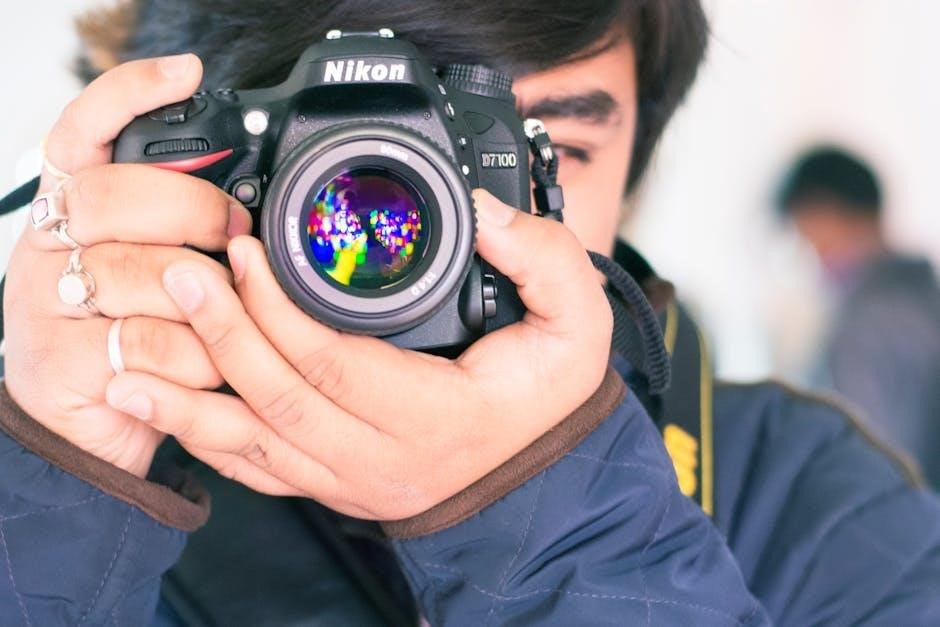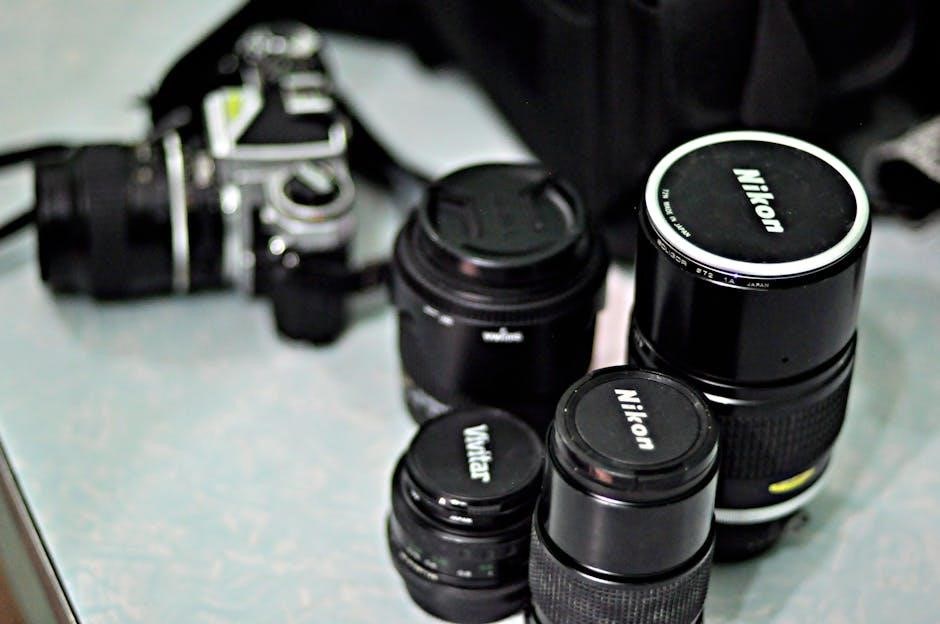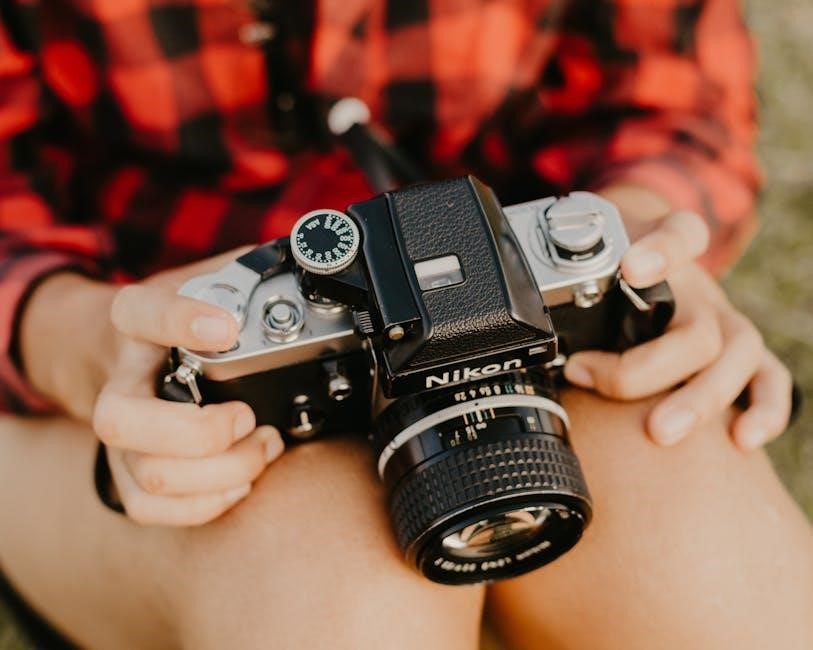The Nikon D50 is a high-quality digital SLR camera designed for both beginners and advanced photographers. Its comprehensive manual provides detailed guidance on setup, shooting modes, and customization, ensuring users can fully utilize its features and troubleshoot common issues effectively.
1.1 Overview of the Nikon D50 Camera
The Nikon D50 is a versatile and user-friendly DSLR camera designed for photographers of all skill levels. It features a 6.1-megapixel sensor, supporting JPEG, NEF, and RAW image formats. The camera offers 11 shooting modes, including automatic and manual options, allowing users to customize settings like ISO, white balance, and shutter speed. Its ergonomic design and intuitive controls make it easy to navigate, while the included manual provides detailed instructions for optimizing its features. The D50 is compatible with a wide range of Nikon lenses, expanding creative possibilities. Whether for casual photography or professional use, the Nikon D50 delivers high-quality results, making it a reliable choice for capturing memorable moments.
1.2 Importance of the Nikon D50 Manual
The Nikon D50 manual is an essential resource for unlocking the camera’s full potential. It provides clear instructions on setup, shooting modes, and customization, helping users master both basic and advanced techniques. The manual explains how to navigate the menu system, configure custom settings, and troubleshoot common issues, ensuring optimal performance. Whether you’re a novice or an experienced photographer, the manual serves as a comprehensive guide to understanding the camera’s features and improving your photography skills. Accessible in PDF format, it offers convenience and detailed insights, making it indispensable for anyone looking to get the most out of their Nikon D50.

Understanding the Nikon D50 Manual
The Nikon D50 manual is a comprehensive guide, detailing setup, shooting modes, customization, and troubleshooting. Available online, it ensures optimal camera utilization and enhances photography experiences.
2.1 How to Access the Nikon D50 Manual
The Nikon D50 manual is readily available online in PDF format, accessible through Nikon’s official website or trusted third-party sources. Users can download it for free by visiting the Nikon support page and selecting the D50 model. Additionally, the Nikon Manual Viewer 2 app allows users to download and view the manual on their smartphones or tablets. The manual is provided in multiple languages, including English and Russian, ensuring accessibility for a global audience. It covers essential topics such as camera setup, shooting modes, flash settings, and troubleshooting. For those without internet access, libraries or purchase options may also provide physical copies. This comprehensive guide is indispensable for mastering the Nikon D50’s features and optimizing photography experiences.
2.2 Structure and Content of the Manual
The Nikon D50 manual is a comprehensive guide organized into clear sections for easy navigation. It begins with an overview of the camera’s basic features and setup, followed by detailed explanations of shooting modes, custom settings, and menu functions. The manual also covers technical specifications, troubleshooting common issues, and advanced techniques for optimizing photography. Included are instructions for using interchangeable lenses, flash settings, and image formats like JPG and RAW. Diagrams and tables are provided to illustrate complex settings, while appendices offer additional resources and references. This structured approach ensures users can quickly find the information they need, making it an indispensable tool for both beginners and experienced photographers seeking to master the Nikon D50.

Key Features of the Nikon D50
The Nikon D50 features a 6.1 MP DX-format sensor, 2.5 fps continuous shooting, SD memory card support, and various shooting modes, catering to both amateur and professional photographers.
3.1 Technical Specifications
The Nikon D50 is equipped with a 6.1-megapixel DX-format CCD sensor, measuring 23.7mm x 15.6mm. It supports SD memory cards and features a 2-inch LCD monitor for image preview and menu navigation. The camera offers ISO sensitivity ranging from 200 to 1600, with the option to adjust settings manually for optimal image quality. It supports various image formats, including JPEG, NEF (RAW), and TIFF. The D50 also features a built-in flash and a hot shoe mount for external flash units. Its shutter speed ranges from 1/4000 to 30 seconds, with a maximum burst mode of 2.5 frames per second. The camera’s lightweight design and intuitive controls make it accessible to photographers of all skill levels.
3.2 Shooting Modes and Functions
The Nikon D50 offers a variety of shooting modes to cater to different photography needs. The Auto Mode is ideal for beginners, automatically adjusting settings for optimal results. The P (Programmed Auto) mode allows for manual adjustments while maintaining automatic exposure. S (Shutter-Priority) and A (Aperture-Priority) modes provide greater control over specific settings, while M (Manual) mode enables full customization. Additionally, the camera features Scene Modes such as Portrait, Landscape, and Night Portrait for tailored results. The D50 also supports Autofocus modes (Single Servo and Continuous Servo), Metering options (Matrix, Center-Weighted, and Spot), and White Balance adjustments. With ISO sensitivity up to 1600 and a Continuous Shooting rate of 2.5 frames per second, the D50 offers versatile functionality for photographers of all levels.

Setting Up Your Nikon D50
Unpack and charge the battery, then mount the lens and format the memory card. Set the language, date, and time for proper camera configuration and operation.
4.1 Unpacking and Initial Setup
When unboxing your Nikon D50, carefully unpack all components, including the camera body, lens, battery, charger, and manual. Ensure all items are undamaged and accounted for. Insert the battery into the charger and charge it fully before first use. Attach the provided lens by aligning the mount and twisting gently. Format the memory card using the camera’s menu to prepare it for use. Set the language, date, and time in the camera’s setup menu for accurate file naming and timestamping. Finally, familiarize yourself with the camera’s controls and settings, referring to the manual for detailed guidance.
4.2 Basic Camera Controls and Layout
The Nikon D50 features an intuitive control layout designed for easy access to essential functions. The Mode Dial on top allows selection of shooting modes such as Auto, P, S, A, and M. The Shutter Release Button is located on the right grip, alongside the Aperture/Exposure Compensation Button. On the rear, the Multi-selector navigates menu options, while the OK Button confirms selections. The LCD Monitor displays settings, images, and menus. The Viewfinder provides a clear preview of your shot. The Focus Switch on the lens toggles between autofocus and manual focus. Familiarize yourself with these controls to optimize your shooting experience. Refer to the manual for detailed explanations of each button and dial’s functionality.
Operating the Nikon D50
Operating the Nikon D50 is straightforward, with intuitive controls for shooting modes, ISO adjustments, and focus settings. The camera offers seamless navigation through its menu system, allowing precise customization of settings for optimal results in various photography scenarios.
5.1 Shooting Modes Explained
The Nikon D50 offers a variety of shooting modes to suit different photography needs. The Auto Mode is ideal for beginners, automatically adjusting settings for point-and-shoot simplicity. Program Mode (P) offers flexibility while maintaining automatic exposure. Shutter Priority (S) allows manual control over shutter speed, perfect for capturing motion. Aperture Priority (A) enables control over aperture for depth of field adjustments. Manual Mode (M) provides full control over both shutter speed and aperture for advanced users. Additional modes like Portrait, Landscape, Close-Up, and Night Portrait optimize settings for specific scenarios, ensuring high-quality results in various lighting conditions. These modes cater to photographers of all skill levels, enhancing creativity and precision.
5.2 Navigating the Menu System
Navigating the Nikon D50’s menu system is straightforward, with options organized into logical categories. The Shooting Menu allows adjustments to settings like ISO, white balance, and autofocus. The Playback Menu offers options for reviewing and editing images. The Setup Menu provides access to camera customization, such as date/time settings and firmware updates. Users can navigate using the multi-selector buttons and confirm selections with the OK button. The menu is user-friendly, with clear descriptions for each option. Custom settings can be saved for quick access, enhancing efficiency. The manual includes detailed explanations of each menu function, ensuring users can fully utilize the camera’s capabilities and personalize their shooting experience.

Advanced Techniques with the Nikon D50
The Nikon D50 supports advanced techniques like custom settings, multiple shooting modes, and ISO adjustments. Users can refine their photography skills by exploring white balance and troubleshooting tips, empowering creative control and stunning image capture.
6.1 Custom Settings and Configuration
The Nikon D50 allows users to customize settings to suit their preferences, ensuring enhanced control over photography. Through the menu system, photographers can adjust autofocus modes, metering types, and white balance settings. Customizing these options enables tailored shooting experiences, whether in automatic or manual modes. The manual provides detailed instructions on configuring these settings, allowing for personalized optimization of camera functions. This feature is particularly useful for advanced users seeking to refine their techniques and achieve precise results in various lighting conditions. By exploring these configurations, photographers can unlock the full potential of their Nikon D50, capturing images with greater precision and creativity.
6.2 Troubleshooting Common Issues
The Nikon D50 manual includes a dedicated section for troubleshooting common problems, ensuring users can quickly resolve issues. Topics covered include resolving autofocus errors, addressing battery life concerns, and fixing image quality problems. The guide provides step-by-step solutions for issues like blurry images, incorrect exposures, and memory card errors. Additionally, it offers advice on maintaining the camera’s performance and preventing potential malfunctions. By referring to this section, photographers can diagnose and fix issues efficiently, minimizing downtime and ensuring optimal camera functionality. This resource is invaluable for both new and experienced users, helping them overcome challenges and continue capturing high-quality images seamlessly.